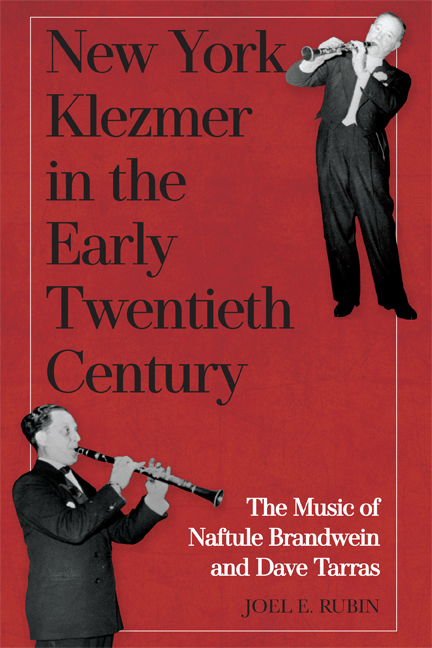Book contents
- Frontmatter
- Contents
- Acknowledgments
- List of Abbreviations
- Note on Orthography and Transliteration
- About the Companion Website
- Introduction: “If You Called Me A Klezmer Thirty-Five Years Ago …”
- 1 A Wedding in Town Was Like a Holiday: A Short History of Klezmorim in Europe
- 2 Klezmer in New York: Changing Meanings, Changing Contexts
- 3 A Kind of “Ethnomusicological Archive”: Commercial 78-rpm Recordings of Klezmer Music
- 4 A Single Field Irrespective of Origin: Polymusicality and Language, Aesthetics, Classification, and Transcription
- 5 “What Mattered Was What’s Happening with the Tune”: Modality and Compositional Processes
- 6 “The Little Things That They Do”: Ornaments and Performance Practice Techniques
- 7 “The Newest Bulgar Out That Everyone Played”: New York Klezmer after 1929
- Glossary
- Notes
- Bibliography
- Index
Introduction: “If You Called Me A Klezmer Thirty-Five Years Ago …”
Published online by Cambridge University Press: 11 September 2020
- Frontmatter
- Contents
- Acknowledgments
- List of Abbreviations
- Note on Orthography and Transliteration
- About the Companion Website
- Introduction: “If You Called Me A Klezmer Thirty-Five Years Ago …”
- 1 A Wedding in Town Was Like a Holiday: A Short History of Klezmorim in Europe
- 2 Klezmer in New York: Changing Meanings, Changing Contexts
- 3 A Kind of “Ethnomusicological Archive”: Commercial 78-rpm Recordings of Klezmer Music
- 4 A Single Field Irrespective of Origin: Polymusicality and Language, Aesthetics, Classification, and Transcription
- 5 “What Mattered Was What’s Happening with the Tune”: Modality and Compositional Processes
- 6 “The Little Things That They Do”: Ornaments and Performance Practice Techniques
- 7 “The Newest Bulgar Out That Everyone Played”: New York Klezmer after 1929
- Glossary
- Notes
- Bibliography
- Index
Summary
“Klezmer music” is a widely used term to designate various genres of vernacular music associated with or derived from the Yiddish-speaking Jews of eastern Europe and their descendants on several continents. Klezmer has undergone a worldwide revival since the 1970s, bringing it far from its roots in Jewish tradition and into the sphere of popular culture. Since the 1980s, it has become one of the most transnationally popular world music genres, generating numerous hybrid forms and influencing musics as diverse as indie rock, avant-garde jazz, and contemporary art music.
In a narrower historical sense, klezmer refers to the music of the largely hereditary socioeconomic group of professional Jewish instrumentalists (pl. klezmorim) in large parts of eastern Europe, who performed a ritual and celebratory function at weddings and other important family and communal celebrations in Jewish life and calendrical cycles. The musical tradition of the klezmorim, which had developed in Europe from approximately the sixteenth century to the early twentieth century, was brought to North America (and elsewhere) with the wave of immigration that began in 1881. In particular, New York City, which by 1915 hosted the largest single concentration of Jews in history, became the major center of Yiddish culture, including klezmer music. Not only was New York's klezmer community large but the breadth of its families and their geographic origins were significant. New York became the center of the Yiddish recording industry and hosted the largest number of Yiddish theaters and Yiddish-language radio stations. It is the vibrant klezmer culture of New York during the early decades of the twentieth century that forms the centerpiece of this book.
Although I am Jewish and the majority of my ancestors stemmed from Yiddish-speaking eastern Europe, I did not grow up in direct contact with this musical tradition. My paternal grandfather, Jack (Jacob) Rubin, was born in 1893 in Kiev. Like his father, Kalmen, before him, he had apprenticed in the barber trade as a youth. My grandfather played Yiddish, Russian, Ukrainian, and American folk music by ear on a six-stringed guitar with an open tuning he had adapted from the Russian seven-stringed instrument. Using his thumb to finger the bass lines, he accompanied balalaika players, mandolinists, and singers, including my step-grandmother, Pauline.
- Type
- Chapter
- Information
- New York Klezmer in the Early Twentieth CenturyThe Music of Naftule Brandwein and Dave Tarras, pp. 1 - 13Publisher: Boydell & BrewerPrint publication year: 2020



